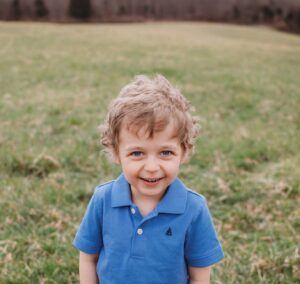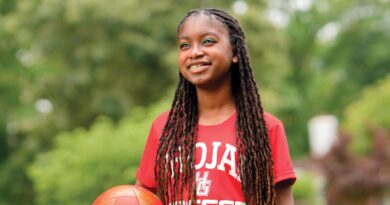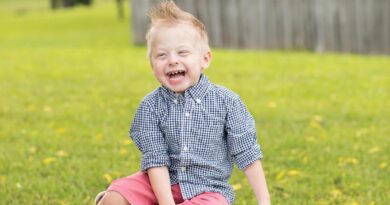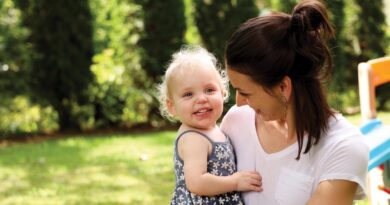The Era of Precision Oncology
Published on July 6th, 2023 by Leigh MacMillan.
More than a year ago, Ysa Engel was close to needing brain surgery. Ysa, 18, has a rare genetic disorder called von Hippel-Lindau (VHL) disease, which causes tumors, both benign and cancerous, and cysts to grow in multiple parts of the body. In Ysa’s case, a brain stem tumor — a benign hemangioblastoma — was beginning to cause vomiting and impact her swallowing and some sensory functions. Although surgical removal was a potential treatment, the area of the tumor was risky.
A new targeted therapeutic, belzutifan, had recently been approved for the treatment of VHL-associated tumors in adults ages 18 and older, and Ysa’s doctor, Debra Friedman, MD, MS, was able to get approval to treat her with the medication.
Within the first two months of belzutifan therapy, her brain stem tumor stabilized and even shrunk a bit.
“Then the tumor stayed stable for a year, which was great because it wasn’t impacting me anymore,” Ysa says. A recent scan suggested that the tumor may be growing slowly again, but Ysa is confident she can face surgery if it’s in her future (see page 21 to read more about VHL and Ysa).
“I was terrified of having brain surgery,” says Ysa, who recently graduated from high school in Canton, Georgia. “Belzutifan gave me room to have a normal life and not have to worry about surgery.”
Belzutifan is one of a growing number of targeted cancer therapies — treatments that target molecular properties that are unique to a cancer, aiming to kill tumor cells without harming healthy tissues.
Monroe Carell Jr. Children’s Hospital at Vanderbilt is a leader in offering targeted cancer therapies to patients, often in clinical trials that are testing whether these therapies can improve outcomes and reduce harm from traditional chemotherapy treatments.
“The molecular findings coming out of laboratories over the last
10 years have been voluminous,” says Friedman, director of the Division of Pediatric Hematology and Oncology. “Month by month we learn more and more about the biologic pathways underlying cancers, and new targeted therapies are developed. We are now really getting to the era of true precision oncology.”
Changing the treatment landscape
Targeted therapies are the latest advance in what has been steady, measured progress in treating children with cancer.
“We cure children today that we didn’t cure when I started treating patients,” says Friedman, who holds the E. Bronson Ingram Chair in Pediatric Oncology. Friedman completed her residency and fellowship training in the early 1990s and joined the Vanderbilt faculty in 2008.
Traditional chemotherapy and radiation, while potentially curative, can have long-term adverse effects that make the “cured patients of today the chronic disease patients of tomorrow,” Friedman says. The hope for precision oncology, she says, “is that we’ll be able to cure children in a more targeted and gentle fashion.”
But bringing targeted therapeutics into pediatric cancer care can be tricky, says Daniel Benedetti, MD, assistant professor of Pediatrics in the Division of Hematology and Oncology at Monroe Carell.
“We’ve had far more limited uses of targeted therapies in pediatric cancer than our colleagues in adult oncology, which reflects the fact that we are very successful at curing childhood cancer,” Benedetti says. “We cure about 85% of all kids who are diagnosed with cancer, and that’s almost exclusively with traditional chemotherapy, radiation and surgery. How do we justify not giving them the standard treatment to give them a targeted therapy that might be as effective, but we haven’t proven that yet?”
To test the effectiveness of new targeted treatments, clinical trials usually try them first in patients who have no further curative options. If the treatments are effective for these patients, then they might be used in a trial of initial relapse, or perhaps as an addition to the standard treatment, Benedetti says.
“It takes a stepwise, iterative process, and because childhood cancer is rare, it can take five years to run a trial and another five to get results. So, we’re moving at slow paces because we have to figure out how to justify using these new drugs when other treatments are so effective,” he says.
For some diagnoses, though, targeted therapies have already changed the treatment landscape, Benedetti says.
Comprehensive care for patients with VHL
Von Hippel-Lindau (VHL) syndrome is a rare genetic disorder that causes tumors and cysts and predisposes patients to developing kidney and pancreatic cancer. Read more »
One is infantile fibrosarcoma, a fast-growing cancer of connective tissue that occurs in infants and young children. The cancer cells usually have a genetic change that is shared by other adult cancers — a chromosomal rearrangement that activates a certain signaling protein. An inhibitor of this activated protein, called larotrectinib, was effective in treating multiple types of cancer with the chromosomal rearrangement.
“This drug has really changed the treatment of infantile fibrosarcoma and any cancer with that genetic change,” Benedetti says. “It’s a small group of patients, but it’s a huge impact. And hopefully, over time, we’ll be able to figure out other places where similar stories can occur.”
Personalized care for patients with neuroblastoma
Benedetti hopes a cancer that will benefit from targeted treatments is neuroblastoma, which develops from immature nerve cells called neuroblasts. It often starts in the adrenal glands but can form in other areas of the abdomen, chest or neck.
Usually diagnosed in children younger than 5, neuroblastoma is the most common solid tumor in children, other than brain tumors as a group. It makes up about 8% of childhood cancer, but accounts for a disproportionate percent of deaths from cancer, about 15%, Benedetti says.
Neuroblastoma is a very heterogeneous disease. Some children need no treatment, and the tumor will regress on its own, while others require only surgery or some chemotherapy. But about half of patients with neuroblastoma have high-risk disease that may have already spread throughout the body. And even with about 18 months of intensive treatment that includes chemotherapy, surgery, autologous stem cell transplant (cells from the patient), radiation therapy and immunotherapy, only half of these patients will be cured.
“Sometimes I sit down with families and say, ‘Your child has a cancer called neuroblastoma, and we don’t need to do anything about it,’ and other times I have to say, ‘Your child has a cancer called neuroblastoma; we’re going to throw the kitchen sink of every possible cancer treatment at it, and we still may not be able to make it go away,’” Benedetti says. “It’s an important set of conversations with families around the idea that cancer can mean a lot of different things.”
Over the last 30 years, clinical trials have made it possible to determine risk categories and personalize care for patients with neuroblastoma based on factors including their age, the stage of the cancer and the cancer’s biology and genetics. Current trials are testing targeted treatments in patients with high-risk neuroblastoma.
“Our outcomes for neuroblastoma are not as good as most pediatric cancers, and so it’s a disease where we’re trying to bring new therapies in as early as we can, once there’s scientific rationale for doing so, and hoping that it will allow us to catch up with other diseases,” Benedetti says.
Two targeted treatments being tested are ALK inhibitors (the ALK gene is mutated in about 15% of neuroblastoma tumors) and a highly radioactive form of the molecule MIBG. Because of its chemical structure, MIBG is absorbed by most neuroblastoma cells, and a less radioactive form of MIBG is used in diagnostic imaging for neuroblastoma. Both ALK inhibitors and radioactive MIBG have been used in patients with recurrent neuro-blastoma and no other treatment options.
“This cancer is even more challenging to treat if it comes back, so we need to try and figure out if these treatments make a difference if we give them earlier,” Benedetti says.
‘There is hope’
Cora Devar is a curly-haired 4-year-old who likes to snuggle her family’s pets, help plant flowers and play basketball with her older brother at their Kingston Springs, Tennessee, home.
Her mother, Chelsea Devar, recounts the grueling treatment Cora had for aggressive neuroblastoma that started in the summer of 2020. Cora seemed to be constantly sick with fevers, and then her parents noticed a swollen lymph node in her neck.

“Her pediatrician sent us to Monroe Carell, and it wasn’t long before all the scans and a biopsy confirmed that it was neuroblastoma,” Devar says. Cora started treatment just before her second birthday in July 2020. She suffered septic shock after the fourth and fifth rounds of chemotherapy and had to be resuscitated after having a cardiac arrest in the emergency room. Fortunately, she did not have any neurological damage, Devar says.
Genetic testing of Cora’s tumor revealed that it had a mutation in the ALK gene, and her parents did not hesitate to enroll her in the clinical trial that added the ALK inhibitor crizotinib to her treatment.
“We were willing to do anything, and we trusted the doctors,” Devar said. “Our feeling was that we were already facing the worst thing with her diagnosis and that we would try anything that might help.”
Benedetti says, “If the tumor cells are driven by a genetic change in ALK, we hope that an ALK inhibitor will improve the sensitivity to chemotherapy and the overall response. It will take us another five years or more to learn and prove whether it makes a difference, but in my patients so far, we’ve at least seen some encouraging responses.”
Patients whose tumors do not have the ALK gene mutation — but whose tumors do take up MIBG — may enroll in a trial of radioactive MIBG as a treatment option, with half of the patients who enroll being randomized to receive the therapy in addition to the standard treatments. Radioactive MIBG delivers radiation directly to the neuroblastoma tumor cells.
Monroe Carell is one of about 20 centers — and the only children’s hospital in Tennessee — with a special lead-lined treatment room where radioactive MIBG can be used.
Connor Stamey, 4, received radioactive MIBG as part of his treatment for high-risk neuroblastoma that was diagnosed in August 2020, when he was one month shy of turning 2. Connor ran a low-grade fever for almost two weeks that summer, and his mother, Heather, repeatedly took him to the family’s pediatric practice in Kingsport, Tennessee.
“I knew something wasn’t right with Connor,” she says, remembering that he had stopped walking and wouldn’t let her put him down.
Ultimately, he was admitted to a regional children’s hospital, where he was diagnosed with juvenile idiopathic arthritis — a diagnosis that brought the family to Monroe Carell for an appointment with a pediatric rheumatologist.
“The rheumatologist examined Connor, looked at me, and said, ‘I don’t think this is JIA. Do you mind if I admit him to the hospital?’” Stamey recalls. “That was a Monday, and by the end of the week he’d had a tumor biopsy and bone marrow biopsy and was starting treatment. We felt like maybe he was misdiagnosed for a reason, that God had led us to Monroe Carell.”

For the radioactive MIBG therapy, Connor was sedated and treated in the lead-lined room, with his parents in a room next door, connected by video and audio and with very limited access to Connor during the four-day treatment.
“Connor did really great; it was much harder on us than on him,” Stamey says. “It was honestly one of the easiest treatments that he went through, with almost no side effects. We were thankful with Connor’s disease that he was randomized to get that additional therapy to hopefully knock it out for good.”
An MIBG scan after the treatment showed that Connor had little or no disease before he completed stem cell transplants, radiation, and finally, immunotherapy.
“MIBG may have been the kicker that got him into remission,” Stamey says.
Both Devar and Stamey praised the nurses and care their children received at Monroe Carell.
“The nurses would sit and play with Cora and kind of tell us to take a break,” Devar says. “They took really good care of her, and the doctors were great. It was easy to try to stay positive with the team that we had.”
Stamey agrees. “We couldn’t have done it without the nurses on the sixth floor,” she says. “They were so supportive, and when Connor felt like it, they would play, play, play with him.
“When we started fighting this nasty disease, we wondered if we’d ever make it to the end, or what the end would look like. Connor is out in the yard playing right now, running around and having fun. There is hope.”




